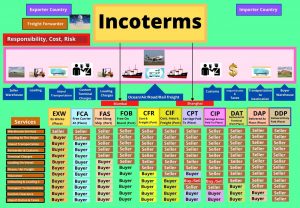6.2 Incoterms Rules
Learning Objective
1. Describe the International Chamber of Commerce (ICC) Incoterms.
Incoterms Rules
Import and export are the critical components of all industries, particularly manufacturing, where imports act as inputs to the production process to export finished goods to their final destinations. International trade is complex because of the many parties involved taking diverse decisions related to transportation, delivery, risks and costs associated, storage, loading, unloading etc. Incoterms (International Commercial Terms) rules try to manage this complexity by guiding importers and exporters on two significant decisions:
- Costs: Who is responsible for expenses associated with the shipment?
- Risks: Who bears the risk of loss or damage to the load?
Incoterms Chart
 Note. Incoterms Chart. From Wikimedia Commons, 2021. CC BY-SA 4.0. [Image description].
Note. Incoterms Chart. From Wikimedia Commons, 2021. CC BY-SA 4.0. [Image description].
Incoterms rules are developed and published by International Chamber of Commerce (ICC) to facilitate the global trading system. The ICC codified their first study of most generally used trade terms as a pre-incoterms edition in 1923 and published their first set of Incoterm Rules in 1936 (Thompson, 2020). Since then, this organization reviews and updates Incoterms rules every ten years, the previous edition was published in 2010 (Lowe, 2020). ICC has announced the latest edition Incoterms 2020 Rules containing 11 terms, which have been effective since 1 January 2020 (See Figure 6.1 for details). The Incoterms 2020 Rules is the ninth edition of Incoterms, which has the aim of being more inclusive and uses simple language for the current international trade decisions (Suraraksa, Amchang, Sawatwong, 2020).
Video: Incoterms 2020 Explained for Import Export Global Trade (6:21)
To know more about Incoterms Rules 2020, read their brief description and also watch this video that explains Incoterms Rules 2020 in detail.
Media 6.2. Incoterms 2020 Explained for Import Export Global Trade [Video]. Inco Docs. (URL: https://youtu.be/7g7IC4IzjDM)
Incoterms Breakdown
To understand Incoterms better, these can be categorized into two parts. One is based on mode of transportation and the other is based on point of delivery. View the following interactive to know more about these categories.
Check Your Understanding
Answer the question(s) below to see how well you understand the topics covered above. You can retake it an unlimited number of times.
Use this quiz to check your understanding and decide whether to (1) study the previous section further or (2) move on to the next section.
Check Your Understanding: Incoterms Rules
Interactive activity unavailable in this format
Text-based alternative to interactive activity available in Chapter 6.7.
Media Attributions and References
Inco Docs. (n.d.). Incoterms 2020 explained for import export global trade [Video]. YouTube. https://youtu.be/7g7IC4IzjDM.
Naveen7829. (2021). Incoterms chart [Chart]. Wikimedia Commons. https://commons.wikimedia.org/wiki/File:%E0%A4%87%E0%A4%A8%E0%A4%95%E0%A5%8B%E0%A4%9F%E0%A4%B0%E0%A5%8D%E0%A4%AE%E0%A5%8D%E0%A4%B8_%E0%A4%9A%E0%A4%BE%E0%A4%B0%E0%A5%8D%E0%A4%9F.jpg.
Receiving the goods in destination country.
Sending the goods from originating country.
Bi-lateral or Multi-lateral exchange of goods and services.
The act of moving goods from origin to destination using different modes such as air, land, sea and pipelines.
The act of storing something in a warehouse.
A person or organization that sells products and services that are sourced from other countries.
A person or organization that sells products and services in foreign countries that are sourced from the home country.

